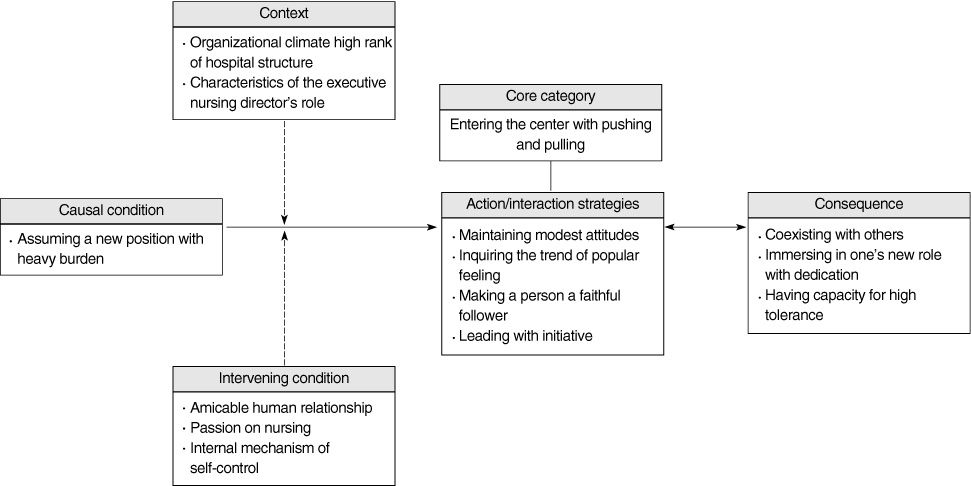J Korean Acad Nurs.
2010 Dec;40(6):785-798. 10.4040/jkan.2010.40.6.785.
The Role Adaptation Process of The Executive Director of Nursing Department
- Affiliations
-
- 1Department of Nursing, Kkottongnae Hyundo University of Social Welfare, Cheongwon, Korea.
- 2Asan Academy Institute/Administration, Asan Medical Center, Seoul, Korea. kopark@amc.seoul.kr
- 3Department of Nursing, Dankook University, Cheonan, Korea.
- KMID: 999481
- DOI: http://doi.org/10.4040/jkan.2010.40.6.785
Abstract
- PURPOSE
The purpose of this study was to identify the role adaptation process experienced by executive directors of nursing department of general hospitals.
METHODS
Data were collected from 9 executive nursing directors though in-depth interviews about their experiences. The main question was "How do you describe your experience of the process of role adaptation as an executive nursing director?" Qualitative data from field and transcribed notes were analyzed using Strauss & Corbin's grounded theory methodology.
RESULTS
The core category of experience of the process of role adaptation as an executive nursing director was identified as "entering the center with pushing and pulling". The participants used five interactional strategies; 'maintaining modest attitudes', 'inquiring about trends of popular feeling', 'making each person a faithful follower', 'collecting & displaying power', 'leading with initiative'. The consequences of role adaptation in executive nursing directors were 'coexisting with others', 'immersing in one's new role with dedication', and 'having capacity for high tolerance'. The types of role adaptations of executive directors in nursing department were friendly type, propulsive type, accommodating type.
CONCLUSION
The results of this study produced useful information for executive nursing directors on designing a self-managerial program to enhance role adaptation based on interactional strategies.
Keyword
MeSH Terms
Figure
Reference
-
1. Castle NG, Shugarman LR. The effects of top management professional development on administrator turnover. Journal of Applied Gerontology. 2005. 24:404–418.2. Chon SJ. A study on the analysis of social network to middle management. Korean Business Review. 2006. 9:1–24.3. Chung HS. Career development and mentoring for women. Korean Small Business Review. 2001. 23:355–382.4. Forret ML, Dougherty TW. Correlates of networking behavior for managerial and professional employees. Group & Organization Management. 2001. 26:283–311.5. George VM. The role of the system chief nurse executive. Nurse Leader. 2005. 3(4):45–49.6. Grady TP, Clark JS, Wiggins MS. The case for clinical nurse leader: guiding nursing practice into the 21st century. Nurse Leader. 2010. 8:37–41.7. Han SS, Kwon SB, Kim MS, Kim YS, Moon HJ, Ahn SH, et al. Nursing Management. 2006. Seoul: SooMoonSa.8. Hessel JA. Presence in nursing practice: A concept analysis. Holistic Nursing Practice. 2009. 23:276–281.9. Havens DS, Thompson PA, Jones CB. Chief nursing officer turnover: Chief nursing officers and healthcare recruiters tell their stories. The Journal of Nursing Administration. 2008. 38:516–525.10. Ibarra H. Paving an alternative route: Gender differences in managerial network. Social Psychological Quarterly. 1997. 16:91–102.11. Jones CB, Havens DS, Thompson PA. Chief nursing officer turnover and the crisis brewing: Views from the front line. The Journal of Nursing Administration. 2009. 39:285–292.12. Koh MS. The effects of self development training on the human relationship and intrinsic motivation of the first-line nurse managers. Journal of Korean Academy of Nursing. 2003. 33:130–137.13. Korean Hospital Nurses Association. The business report year of 2009. 2010. 02. Seoul. Korea: Author.14. Kwag SH. Women-friendly HRM and women's position in labor market. Journal of Human Resource Management Research. 2007. 14(4):1–16.15. Lee BS, Kang SR, Kim HO. Experience of job satisfaction in clinical nurses: Application of focus group methodology. Journal of Korean Academy of Nursing. 2007. 37:114–124.16. McConnell CR. The manager and the manager: Adaptation and survival in the blended organization. The Health Care Manager. 2000. 19:1–11.17. Melamed T. Career success: The moderation effect of gender. Journal of Vocational Behavior. 1995. 47:35–60.18. Morrison EW. Newcomers' relationships: The role of social network ties during socialization. Academy of Management Journal. 2002. 45:1149–1160.19. Park KS. The Director of Hospital, not Chief Executive Officer. 2006. Seoul: Elio & Company.20. Park SA, Kim JH, Park KO, Kim MS, Kim SY. Development a tool for evaluating nurses' performance in hospital units. Journal of Korean Clinical Nursing Research. 2009. 15(2):5–21.21. Park SH. A study on the leadership of women managers. Journal of Local Education Management. 2000. 5:159–178.22. Sandelowski M. The problem of rigor in qualitative research. Advances in Nursing Science. 1986. 8(3):27–37.23. Seo DH. The analysis on resistance factors of the organization members against managerial women: Public and private organization comparative perspective. Korean Policy Studies Review. 2008. 17:365–376.24. Strauss A, Corbin J. Basic of qualitative research: Techniques and procedures for developing grounded theory. 1998. Thousand Oaks: Sage Publications.25. Wellington SW. Be your own mentor: Strategies from top women on the secrets of success. 2001. New York: Random House.26. Yang CH. The business competency and female leadership. Korean Corporation Management Review. 2003. 10:139–168.
- Full Text Links
- Actions
-
Cited
- CITED
-
- Close
- Share
- Similar articles
-
- The Adaptation Process of Male Students in Colleges of Nursing
- The Role Adaptation Process of Head Nurses in the General Hospitals
- Role Adaptation Process of Elementary School Health Teachers: Establishing Their Own Positions
- Role Adaptation Process of Hospice Nurses
- The Illness Adaptation Process of Patients Suffering from Atrial Fibrillation: Living a Life Managing the Silent Insurrection of the Heart


